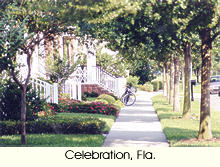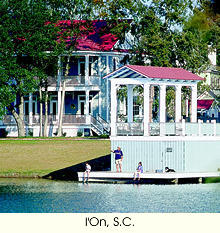
Welcome to the New Urbanism
 After
50 years of living in places that are far from work, entertainment and
institutional buildings, there has been an increased demand for places
that have it all. Places where residents, if they so desire, can live
quite comfortably without an automobile. Where most of the daily activities
are located within walking distance and are connected by attractive streets
and public spaces. In addition, it would be ideal to have a variety of
travel options, housing for all and protected natural areas. An attempt
to deliver these amenities in one package is a form of planning called
new urbanism.
After
50 years of living in places that are far from work, entertainment and
institutional buildings, there has been an increased demand for places
that have it all. Places where residents, if they so desire, can live
quite comfortably without an automobile. Where most of the daily activities
are located within walking distance and are connected by attractive streets
and public spaces. In addition, it would be ideal to have a variety of
travel options, housing for all and protected natural areas. An attempt
to deliver these amenities in one package is a form of planning called
new urbanism.
 Why
do we need new urbanism? Isn't the conventional way of building good enough?
Why
do we need new urbanism? Isn't the conventional way of building good enough?
The planning of conventional suburbs is based on the
rigid separation of land uses. The assumption is that everyone going from
place to place will use a car. Consequently, modern cities have become
dominated by pavement that sprawls in vast distances across the landscape.
In the process, farms and wilderness are destroyed. Residents spend much
of their day in traffic, and everyone budgets a lot of money for transportation.
 Those
who can't drive -- the poor, the elderly and children -- are more restricted
and dependent than everyone else.
Those
who can't drive -- the poor, the elderly and children -- are more restricted
and dependent than everyone else.
If people are going to walk, there have to be places to go and things to do nearby. There must be an assortment of private, commercial and public buildings; these buildings must be connected by a variety of public spaces. Good neighborhoods also have a balance of jobs, housing and services.
A new urban neighborhood (also known as traditional neighborhood development, or TND) is created at the human scale. Buildings are placed closer together and exteriors are designed to be safe and attractive for pedestrians. Streets are constructed for slower speeds and traffic is dispersed through many different connections. Walking in front of a business or around town is simply a pleasant, interesting activity.
Neighborhoods like these have survived and prospered over the centuries. New urbanism returns to these time-tested principles and adapts them for a healthy, sustainable 21st century.